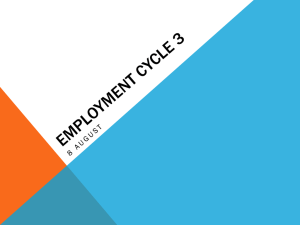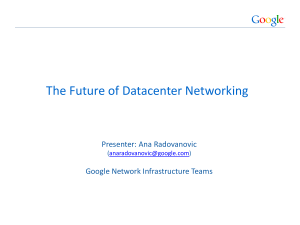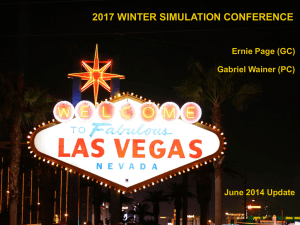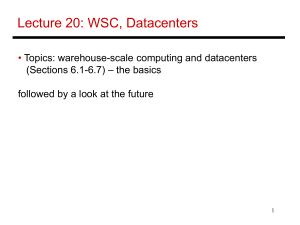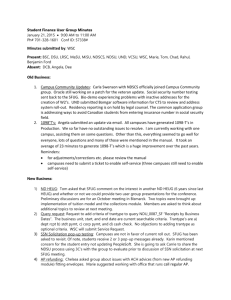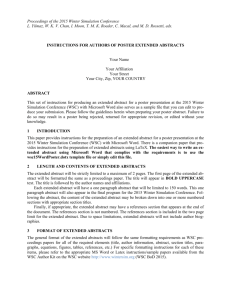Agenda Old School CS61c New School CS61c
advertisement
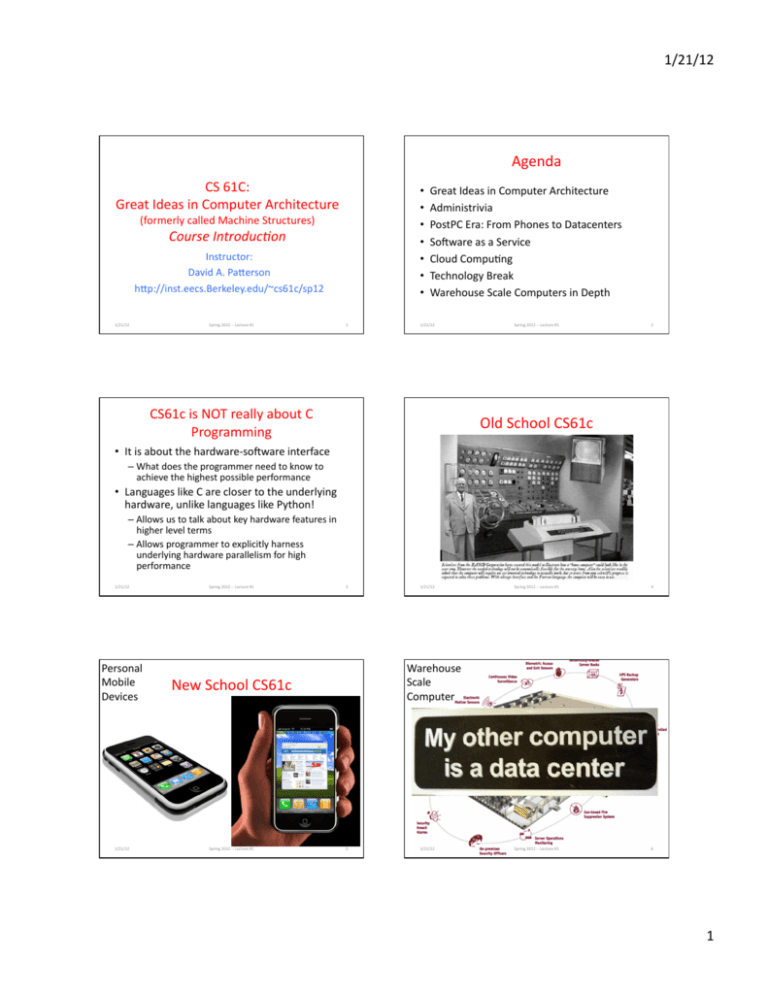
1/21/12 Agenda CS 61C: Great Ideas in Computer Architecture (formerly called Machine Structures) Course Introduc-on • • • • • • • Instructor: David A. PaDerson hDp://inst.eecs.Berkeley.edu/~cs61c/sp12 1/21/12 Spring 2012 -­‐-­‐ Lecture #1 1 Great Ideas in Computer Architecture Administrivia PostPC Era: From Phones to Datacenters SoOware as a Service Cloud CompuQng Technology Break Warehouse Scale Computers in Depth 1/21/12 CS61c is NOT really about C Programming Spring 2012 -­‐-­‐ Lecture #1 2 Old School CS61c • It is about the hardware-­‐soOware interface – What does the programmer need to know to achieve the highest possible performance • Languages like C are closer to the underlying hardware, unlike languages like Python! – Allows us to talk about key hardware features in higher level terms – Allows programmer to explicitly harness underlying hardware parallelism for high performance 1/21/12 Personal Mobile Devices 1/21/12 Spring 2012 -­‐-­‐ Lecture #1 3 Spring 2012 -­‐-­‐ Lecture #1 4 Spring 2012 -­‐-­‐ Lecture #1 6 Warehouse Scale Computer New School CS61c Spring 2012 -­‐-­‐ Lecture #1 1/21/12 5 1/21/12 1 1/21/12 New-­‐School Machine Structures (It’s a bit more complicated!) Project 1 Old-­‐School Machine Structures Applica6on (ex: browser) Compiler SoHware Hardware Assembler Processor So/ware Hardware • Parallel Requests CS61c Opera6ng System (Mac OSX) Assigned to computer e.g., Search “Katz” • Parallel Threads Parallelism & Assigned to core e.g., Lookup, Ads Memory I/O system Leverage Achieve High Performance Project 2 • Parallel InstrucQons Instruc6on Set Architecture Input/Output InstrucQon Unit(s) >1 data item @ one Qme e.g., Add of 4 pairs of words transistors Cache Memory All gates funcQoning in parallel at same Qme 7 1/21/12 • Programming Languages Logic Gates Project 8 4 Spring 2012 -­‐-­‐ Lecture #1 Great Idea #1: Levels of RepresentaQon/InterpretaQon 6 Great Ideas in Computer Architecture 1. 2. 3. 4. 5. 6. Project 3 Core FuncQonal Unit(s) A0+B0 A1+B1 A2+B2 A3+B3 • Hardware descripQons Spring 2012 -­‐-­‐ Lecture #1 Core Memory • Parallel Data Digital Design Circuit Design Computer … Core >1 instrucQon @ one Qme e.g., 5 pipelined instrucQons Datapath & Control 1/21/12 Smart Phone Warehouse Scale Computer temp = v[k]; v[k] = v[k+1]; v[k+1] = temp; High Level Language Program (e.g., C) Layers of RepresentaQon/InterpretaQon Moore’s Law Principle of Locality/Memory Hierarchy Parallelism Performance Measurement & Improvement Dependability via Redundancy Compiler Assembly Language Program (e.g., MIPS) lw lw sw sw Assembler Machine Language Program (MIPS) $t0, 0($2) $t1, 4($2) $t1, 0($2) $t0, 4($2) 0000 1010 1100 0101 1001 1111 0110 1000 1100 0101 1010 0000 Anything can be represented as a number, i.e., data or instrucQons 0110 1000 1111 1001 1010 0000 0101 1100 1111 1001 1000 0110 0101 1100 0000 1010 1000 0110 1001 1111 ! Machine Interpreta4on Hardware Architecture Descrip6on (e.g., block diagrams) Architecture Implementa4on Logic Circuit Descrip6on 1/21/12 Spring 2012 -­‐-­‐ Lecture #1 9 Predicts: 2X Transistors / chip every 2 years 10 Great Idea #3: Principle of Locality/ Memory Hierarchy #2: Moore’s Law # of transistors on an integrated circuit (IC) 1/21/12 (Circuit Schema6c Diagrams) Spring 2012 -­‐-­‐ Lecture #1 Gordon Moore, Intel Cofounder B.S. Cal 1950 Cal Alumni of Year 1997 1/21/12 Spring 2012 -­‐-­‐ Lecture #1 Year 11 1/21/12 Spring 2012 -­‐-­‐ Lecture #1 12 2 1/21/12 Great Idea #5: Performance Measurement and Improvement Great Idea #4: Parallelism • Matching applicaQon to underlying hardware to exploit: – Locality – Parallelism – Special hardware features, like specialized instrucQons (e.g., matrix manipulaQon) • Latency – How long to set the problem up – How much faster does it execute once it gets going – It is all about -me to finish 1/21/12 Spring 2012 -­‐-­‐ Lecture #1 13 1/21/12 Spring 2012 -­‐-­‐ Lecture #1 14 1/21/12 Spring 2012 -­‐-­‐ Lecture #1 15 1/21/12 Spring 2012 -­‐-­‐ Lecture #1 16 Great Idea #6: Dependability via Redundancy Great Idea #6: Dependability via Redundancy • Redundancy so that a failing piece doesn’t make the whole system fail • Applies to everything from datacenters to storage to memory 1+1=2 1+1=2 2 of 3 agree 1+1=2 1+1=1 – Redundant datacenters so that can lose 1 datacenter but Internet service stays online – Redundant disks so that can lose 1 disk but not lose data (Redundant Arrays of Independent Disks/RAID) – Redundant memory bits of so that can lose 1 bit but no data (Error CorrecQng Code/ECC Memory) FAIL! Increasing transistor density reduces the cost of redundancy 1/21/12 Spring 2012 -­‐-­‐ Lecture #1 17 1/21/12 Spring 2012 -­‐-­‐ Lecture #1 18 3 1/21/12 Agenda QuesQon: Which statement is TRUE about Big Ideas in Computer Architecture? ☐ ☐ ☐ • • • • • • • To offer a dependable system, you must use components that almost never fail Memory hierarchy goal: look ≈as fast as most expensive memory, ≈ as big as cheapest Moore’s Law means computers get twice as fast every ≈ 1.5 years ☐ 19 Great Ideas in Computer Architecture Administrivia PostPC Era: From Phones to Datacenters SoOware as a Service Cloud CompuQng Technology Break Warehouse Scale Computers in Depth 1/21/12 Course InformaQon • Course Web: hDp://inst.eecs.Berkeley.edu/~cs61c/sp12sp • Instructor: – Dave PaDerson • Teaching Assistants: – Rimas Avizienis, ScoD Beamer, Alan Christopher, Eric Liang, Paul Ruan, Ian Vonseggern • Textbooks: Average 15 pages of reading/week – Barroso & Holzle, The Datacenter as a Computer (free download from web page) – PaDerson & Hennessey, Computer Organiza-on and Design, Revised 4th EdiQon (not ≤3rd EdiQon, not Asian 4th ediQon) – Kernighan & Ritchie, The C Programming Language, 2nd EdiQon • Piazza for class announcements, Q&A: – Just go to Piazza web page and add yourself to the class – Staff reads them all; please keep it class related and professional 1/21/12 Spring 2012 -­‐-­‐ Lecture #1 21 • Discussions and labs will be held this week – Switching SecQons: if you find another 61C student willing to swap discussion AND lab, talk to your TAs – Partner (projects 1, 3, and extra credit): OK if partners mix secQons but have same TA • First homework assignment due this Sunday January 22rd by 11:59:59 PM – There is reading assignment as well on course page 1/21/12 Spring 2012 -­‐-­‐ Lecture #1 22 EECS Grading Policy • Grading • hDp://www.eecs.berkeley.edu/Policies/ugrad.grading.shtml “A typical GPA for courses in the lower division is 2.7. This GPA would result, for example, from 17% A's, 50% B's, 20% C's, 10% D's, and 3% F's. A class whose GPA falls outside the range 2.5 -­‐ 2.9 should be considered atypical.” • Spring 2011: GPA 2.85 Fall Spring 24% A's, 49% B's, 18% C's, 2011 2.72 2.85 6% D's, 3% F's 2010 2.81 2.81 • Job/Intern Interviews: They grill you with technical quesQons, so 2009 2.71 2.81 it’s what you say, not your GPA 2008 2.95 2.74 (New 61c gives good stuff to say) 2007 2.67 2.76 – ParQcipaQon and Altruism (5%) – Homework (5%) – Labs (20%) – Projects (40%) 1. Data Parallelism (Map-­‐Reduce on Amazon EC2, with partner) 2. Computer InstrucQon Set Simulator (C) 3. Performance Tuning of a Parallel ApplicaQon/Matrix MulQply using cache blocking, SIMD, MIMD (OpenMP, with partner) 4. Computer Processor Design (Logisim) – Extra Credit: Matrix MulQply CompeQQon, anything goes – Midterm (10%): 6-­‐9 PM Tuesday March 6, 155 Dwinelle – Final (20%): 11:30-­‐2:30 PM Wednesday May 9 Spring 2012 -­‐-­‐ Lecture #1 20 Reminders Course OrganizaQon 1/21/12 Spring 2012 -­‐-­‐ Lecture #1 23 1/21/12 Spring 2012 -­‐-­‐ Lecture #1 24 4 1/21/12 Policy on Assignments and Independent Work Late Policy • Assignments due Sundays at 11:59:59 PM • Late homeworks not accepted (100% penalty) • Late projects get 20% penalty, accepted up to Tuesdays at 11:59:59 PM – No credit if more than 48 hours late – No “slip days” in 61C • Used by Dan Garcia and a few faculty to cope with 100s of students who oOen procrasQnate without having to hear the excuses, but not widespread in EECS courses • More late assignments if everyone has no-­‐cost opQons; beDer to learn now how to cope with real deadlines 1/21/12 Spring 2012 -­‐-­‐ Lecture #1 25 • With the excepQon of laboratories and assignments that explicitly permit you to work in groups, all homeworks and projects are to be YOUR work and your work ALONE. • You are encouraged to discuss your assignments with other students, and extra credit will be assigned to students who help others, parQcularly by answering quesQons on the Google Group, but we expect that what you hand is yours. • It is NOT acceptable to copy soluQons from other students. • It is NOT acceptable to copy (or start your) soluQons from the Web. • We have tools and methods, developed over many years, for detecQng this. You WILL be caught, and the penalQes WILL be severe. • At the minimum a ZERO for the assignment, possibly an F in the course, and a leDer to your university record documenQng the incidence of cheaQng. • (We caught people last Qme taught 61C!) 1/21/12 Spring 2012 -­‐-­‐ Lecture #1 YOUR BRAIN ON COMPUTERS; Hooked on Gadgets, and Paying a Mental Price NY Times, June 7, 2010, by MaD Richtel SAN FRANCISCO -­‐-­‐ When one of the most important e-­‐mail messages of his life landed in his in-­‐box a few years ago, Kord Campbell overlooked it. Not just for a day or two, but 12 days. He finally saw it while siOing through old messages: a big company wanted to buy his Internet start-­‐up. ''I stood up from my desk and said, 'Oh my God, oh my God, oh my God,' '' Mr. Campbell said. ''It's kind of hard to miss an e-­‐mail like that, but I did.'' The message had slipped by him amid an electronic flood: two computer screens alive with e-­‐mail, instant messages, online chats, a Web browser and the computer code he was wriQng. While he managed to salvage the $1.3 million deal aOer apologizing to his suitor, Mr. Campbell conQnues to struggle with the effects of the deluge of data. Even aOer he unplugs, he craves the sQmulaQon he gets from his electronic gadgets. He forgets things like dinner plans, and he has trouble focusing on his family. His wife, Brenda, complains, ''It seems like he can no longer be fully in the moment.'' The Rules (and we really mean it!) This is your brain on computers. ScienQsts say juggling e-­‐mail, phone calls and other incoming informaQon can change how people think and behave. They say our ability to focus is being undermined by bursts of informaQon. These play to a primiQve impulse to respond to immediate opportuniQes and threats. The sQmulaQon provokes excitement -­‐-­‐ a dopamine squirt -­‐-­‐ that researchers say can be addicQve. In its absence, people feel bored. The resulQng distracQons can have deadly consequences, as when cellphone-­‐wielding drivers and train engineers cause wrecks. And for millions of people like Mr. Campbell, these urges can inflict nicks and cuts on creaQvity and deep thought, interrupQng work and family life. While many people say mulQtasking makes them more producQve, research shows otherwise. Heavy mulQtaskers actually have more trouble focusing and shu~ng out irrelevant informaQon, scienQsts say, and they experience more stress. And scienQsts are discovering that even aOer the mulQtasking ends, fractured thinking and lack of focus persist. In other words, this is also your brain off computers. Fall 2010 -­‐-­‐ Lecture #2 27 1/21/12 Architecture of a Lecture Spring 2012 -­‐-­‐ Lecture #1 28 Architecture of a Lecture Full Full Administrivia Tech “And in break conclusion…” ADenQon 0 20 25 50 53 Spring 2012 -­‐-­‐ Lecture #1 Administrivia Tech “And in break conclusion…” ADenQon 78 80 0 Time (minutes) 1/21/12 26 20 25 50 53 78 80 Time (minutes) 29 1/21/12 Spring 2012 -­‐-­‐ Lecture #1 30 5 1/21/12 Peer InstrucQon QuesQon: Which statements are TRUE about this class? • Increase real-­‐Qme learning in lecture, test understanding of concepts vs. details mazur-www.harvard.edu/education/pi.phtml • As complete a “segment” ask mulQple choice quesQon ☐ – <1 minute: decide yourself, vote – <2 minutes: discuss in pairs, then team vote; flash card to pick answer ☐ ☐ • Try to convince partner; learn by teaching • Mark and save flash cards (get in discussion secQon) 1 2 3 ☐ 4 32 Agenda • • • • • • • Computer Eras: Mainframe 1950s-­‐60s Processor (CPU) Great Ideas in Computer Architecture Administrivia PostPC Era: From Phones to Datacenters SoOware as a Service Cloud CompuQng Technology Break Warehouse Scale Computers in Depth 1/21/12 The midterm is Tuesday March 6 during class (9:30-­‐11) The midterm is Tuesday March 6 in the evening (6-­‐9PM) in 155 Dwinelle It’s OK to book airline Qckets before May 9; PaDerson will surely let me take final early Spring 2012 -­‐-­‐ Lecture #1 I/O “Big Iron”: IBM, UNIVAC, … build $1M computers for businesses => COBOL, Fortran, Qmesharing OS 33 1/21/12 Spring 2012 -­‐-­‐ Lecture #1 34 Minicomputer Eras: 1970s PC Era: Mid 1980s -­‐ Mid 2000s Using integrated circuits, Digital, HP… build $10k computers for labs, universiQes => C, UNIX OS Using microprocessors, Apple, IBM, … build $1k computer for 1 person => Basic, Java, Windows OS 1/21/12 1/21/12 Spring 2012 -­‐-­‐ Lecture #1 35 Spring 2012 -­‐-­‐ Lecture #1 36 6 1/21/12 Advanced RISC Machine (ARM) instrucQon set inside the iPhone PostPC Era: Late 2000s -­‐ ?? 1/21/12 Personal Mobile Devices (PMD): Relying on wireless networking, Apple, Nokia, … build $500 smartphone and tablet computers for individuals => ObjecQve C, Android OS Cloud CompuQng: Using Local Area Networks, Amazon, Google, … build $200M Warehouse Scale Computers with 100,000 servers for Internet Services for PMDs => MapReduce, Ruby n R-­‐-­‐ ails Spring o 2012 Lecture #1 iPhone Innards Processor 37 You will how to design and program a related RISC computer: MIPS 1/21/12 Spring 2012 -­‐-­‐ Lecture #1 38 Why Not 80x86 vs. MIPS? I/O • Once learn one, easy to pick up others • 80x86 instrucQon set is not beauQful – ≈ Full suitcase then add clothes on way to plane – Class Qme precious; why spend on minuQae? 1 GHz ARM Cortex A8 I/O Memory You will about mulQple processors, data level parallelism, caches in 61C 1/21/12 Spring 2012 -­‐-­‐ Lecture #1 I/O 2010: 6.1B ARM, 0.3B 80x86 (20X more) 39 Agenda • • • • • • • Spring 2012 -­‐-­‐ Lecture #1 1/21/12 Spring 2012 -­‐-­‐ Lecture #1 40 SoOware as a Service: SaaS Great Ideas in Computer Architecture Administrivia PostPC Era: From Phones to Datacenters SoOware as a Service Cloud CompuQng Technology Break Warehouse Scale Computers in Depth 1/21/12 • MIPS represents energy efficient processor of client (PostPC era) vs. fast processor of desktop (PC era) • MIPS represents more popular instrucQon set: • TradiQonal SW: binary code installed and runs wholly on client device • SaaS delivers SW & data as service over Internet via thin program (e.g., browser) running on client device – Search, social networking, video • Now also SaaS version of tradiQonal SW – E.g., MicrosoO Office 365, TurboTax Online 41 42 7 1/21/12 6 Reasons for SaaS 1. 2. 3. 4. No install worries about HW capability, OS No worries about data loss (at remote site) Easy for groups to interact with same data If data is large or changed frequently, simpler to keep 1 copy at central site 5. 1 copy of SW, controlled HW environment => no compaQbility hassles for developers 6. 1 copy => simplifies upgrades for developers and no user upgrade requests SaaS Infrastructure? • SaaS demands on infrastructure 1. CommunicaQon: allow customers to interact with service 2. Scalability: fluctuaQons in demand during + new services to add users rapidly 3. Dependability: service and communicaQon conQnuously available 24x7 43 44 Clusters • Clusters: Commodity computers connected by commodity Ethernet switches 1. More scalable than convenQonal servers 2. Much cheaper than convenQonal servers – 20X for equivalent vs. largest servers 3. Few operators for 1000s servers – Careful selecQon of idenQcal HW/SW – Virtual Machine Monitors simplify operaQon 4. Dependability via extensive redundancy 45 Warehouse Scale Computers • Economies of scale pushed down cost of largest datacenter by factors 3X to 8X – Purchase, house, operate 100K v. 1K computers • TradiQonal datacenters uQlized 10% -­‐ 20% • Make profit offering pay-­‐as-­‐you-­‐go use at less than your costs for as many computers as you need 47 Agenda • • • • • • • Great Ideas in Computer Architecture Administrivia PostPC Era: From Phones to Datacenters SoOware as a Service Cloud CompuQng Technology Break Warehouse Scale Computers in Depth 1/21/12 Spring 2012 -­‐-­‐ Lecture #1 46 UQlity CompuQng / Public Cloud CompuQng • Offers compuQng, storage, communicaQon at pennies per hour • No premium to scale: 1000 computers @ 1 hour = 1 computer @ 1000 hours • Illusion of infinite scalability to cloud user – As many computers as you can afford • Leading examples: Amazon Web Services, Google App Engine, MicrosoO Azure 48 8 1/21/12 2012 AWS Instances & Prices Instance Standard Small Standard Large Standard Extra Large High-Memory Extra Large High-Memory Double Extra Large High-Memory Quadruple Extra Large High-CPU Medium High-CPU Extra Large Cluster Quadruple Extra Large Eight Extra Large Per Hour Ratio Compute to Units Small $0.085 $0.340 $0.680 $0.500 $1.200 $2.400 $0.170 $0.680 $1.300 $2.400 1.0 4.0 8.0 5.9 14.1 28.2 2.0 8.0 15.3 28.2 1.0 4.0 8.0 6.5 13.0 26.0 5.0 20.0 33.5 88.0 Virtual Compute Memory Cores Unit/ Core (GB) 1 2 4 2 4 8 2 8 16 32 1.00 2.00 2.00 3.25 3.25 3.25 2.50 2.50 2.09 2.75 1.7 7.5 15.0 17.1 34.2 68.4 1.7 7.0 23.0 60.5 Supercomputer for hire Disk (GB) Address 160 850 1690 420 850 1690 350 1690 1690 1690 32 64 64 64 64 64 32 64 64 64 bit bit bit bit bit bit bit bit bit bit • Top 500 supercomputer compeQQon • 290 Eight Extra Large (@ $2.40/hour) = 240 TeraFLOPS • 42nd/500 supercomputer @ ~$700 per hour • Credit card => can use 1000s computers • FarmVille on AWS – Prior biggest online game 5M users – What if startup had to build datacenter? How big? – 4 days =1M; 2 months = 10M; 9 months = 75M 49 50 IBM Watson for Hire? Which statements are NOT true about SaaS and Cloud CompuQng? • Jeopardy Champion IBM Watson • Hardware: 90 IBM Power 750 servers ☐ – 3.5 GHz 8 cores/server • 90 @ ~$2.40/hour = ~$200/hour • Cost of human lawyer or account • For what tasks could AI be as good as highly trained person @ $200/hour? • What would this mean for society? ☐ ☐ Clusters are collecQons of commodity servers connected by LAN switches The Internet supplies the communicaQon for SaaS Cloud compuQng uses HW clusters + SW layer using redundancy for dependability ☐ 51 52 E.g., Google’s Oregon WSC Equipment Inside a WSC Server (in rack format): 1 ¾ inches high “1U”, x 19 inches x 16-­‐20 inches: 8 cores, 16 GB DRAM, 4x1 TB disk 1/21/12 Spring 2012 -­‐-­‐ Lecture #1 53 Array (aka cluster): 16-­‐32 server racks + larger local area network 7 foot Rack: 40-­‐80 servers + Ethernet switch (“array switch”) local area network (1-­‐10 Gbps) switch 10X faster => cost 100X: in middle (“rack switch”) 2 1/21/12 Spring 2012 -­‐-­‐ Lecture #1 cost f(N ) 54 9 1/21/12 Server, Rack, Array Google Server Internals Google Server 1/21/12 Spring 2012 -­‐-­‐ Lecture #1 55 1/21/12 Coping with Performance in Array -- 1 30 1 80 2400 Cores (Processors) 8 640 19,200 16 1,280 38,400 DRAM Capacity (GB) Disk Capacity (GB) Workload Racks 2X 4,000 320,000 9,600,000 DRAM Latency (microseconds) 0.1 100 300 Disk Latency (microseconds) 10,000 11,000 12,000 DRAM Bandwidth (MB/sec) 20,000 100 10 Disk Bandwidth (MB/sec) Spring 2012 -­‐-­‐ Lecture #1 200 100 10 57 1/21/12 Midnight • WSC SoOware must take care where it places data within an array to get good performance • WSC SoOware must cope with failures gracefully • WSC SoOware must scale up and down gracefully in response to varying demand • More elaborate hierarchy of memories, failure tolerance, workload accommodaQon makes WSC soOware development more challenging than soOware for single computer Spring 2012 -­‐-­‐ Lecture #1 59 Noon Midnight • Online service: Peak usage 2X off-­‐peak 1/21/12 Impact of latency, bandwidth, failure, varying workload on WSC soOware? 1/21/12 56 Coping with Workload VariaQon Lower latency to DRAM in another server than local disk Higher bandwidth to local disk than to DRAM in another server Local Rack Array Servers Spring 2012 -­‐-­‐ Lecture #1 Spring 2012 -­‐-­‐ Lecture #1 58 Power vs. Server UQlizaQon • • • • • Server power usage as load varies idle to 100% Uses ½ peak power when idle! Uses ⅔ peak power when 10% uQlized! 90%@ 50%! Most servers in WSC uQlized 10% to 50% Goal should be Energy-­‐Propor-onality: % peak load = % peak energy 1/21/12 Spring 2012 -­‐-­‐ Lecture #1 60 10 1/21/12 Power Usage EffecQveness PUE in the Wild (2007) • Overall WSC Energy Efficiency: amount of computaQonal work performed divided by the total energy used in the process • Power Usage EffecQveness (PUE): Total building power / IT equipment power – An power efficiency measure for WSC, not including efficiency of servers, networking gear – 1.0 = perfecQon 1/21/12 Spring 2012 -­‐-­‐ Lecture #1 61 High PUE: Where Does Power Go? Uninterruptable Power Supply (baDery) Power DistribuQon Unit Servers + Networking 1/21/12 Spring 2012 -­‐-­‐ Lecture #1 1/21/12 62 Servers and Networking Power Only Chiller cools warm water from Air CondiQoner Computer Room Air CondiQoner 63 Peak Power % 1/21/12 Containers in WSCs Inside WSC Spring 2012 -­‐-­‐ Lecture #1 Inside Container Spring 2012 -­‐-­‐ Lecture #1 64 Google WSC A PUE: 1.24 1. Careful air flow handling • Don’t mix server hot air exhaust with cold air (separate warm aisle from cold aisle) 2. Elevated cold aisle temperatures • 81°F instead of tradiQonal 65°-­‐ 68°F 3. Measure vs. esQmate PUE, publish PUE, and improve operaQon • Note – subject of markeQng – Average on a good day with arQficial load (Facebook’s 1.07) or real load for quarter (Google) 1/21/12 Spring 2012 -­‐-­‐ Lecture #1 65 1/21/12 Spring 2012 -­‐-­‐ Lecture #1 66 11 1/21/12 Google WSC PUE: Quarterly Avg Which statements are NOT true about Warehouse Scale CompuQng? ☐ ☐ PUE ☐ Servers, IT equipment represent less than half of WSC power budget The Internet supplies the communicaQon for SaaS Power Usage EffecQveness (PUE) also measures efficiency of the individual servers ☐ • www.google.com/corporate/green/datacenters/measuring.htm 1/21/12 Spring 2012 -­‐-­‐ Lecture #1 67 68 Summary • CS61c: Learn 6 great ideas in computer architecture to enable high performance programming via parallelism, not just learn C 1. 2. 3. 4. 5. 6. Layers of RepresentaQon/InterpretaQon Moore’s Law Principle of Locality/Memory Hierarchy Parallelism Performance Measurement and Improvement Dependability via Redundancy • Post PC Era: Parallel processing, smart phone to WSC • WSC SW must cope with failures, varying load, varying HW latency bandwidth • WSC HW sensiQve to Spring cost, energy efficiency 1/21/12 2012 -­‐-­‐ Lecture #1 69 12
